A Creative Approach for the Architectural Technology: Using the ExtrArtis Model to Regenerate the Built Environment
Abstract
1. Introduction
2. Building a Theoretical Background for a Creative Regeneration
2.1. Culture and Creative Companies as a Motor for Built Heritage Regeneration and Economic Vitality
2.2. From Europe to Italy towards a Culture-Led Regeneration of the Built Environment
- innovation support (the analysis of innovation management and improvement skills, consultancy on the management of intellectual and industrial property, support for technology transfer/open innovation, patent brokerage, partner research for technological cooperation, and enhancement of research results);
- development of partnerships (research for technological/productive/commercial cooperation, identification of partners for participation in European projects, transnational brokerage events, technological/commercial cooperation missions, and international fairs);
- growth and development in foreign markets (information on European policies and legislation, single market and international standards, strategy for foreign markets, support for startups/spin-offs and new entrepreneurship, assistance to facilitate access to finance, contacts with Italian and international public/private investors).
2.3. How Can Creative Enterprises Improve the Built Environment and Its Communities?
3. An Iterative Innovation Process: A New Methodology for Merging Creative Companies and Built-Environment Regeneration
3.1. Methods and Analysis for Innovation and Culture-Led Regeneration
3.2. ExtrArtis© Model as Methodological Improvement of Culture-Led Regeneration
4. Materials: Artists’ Residence Practices as Creative Companies’ Tools for Culture-Led Regeneration
5. Results and Discussion: ExtrArtis, Artists Residencies for Creative Economy©
6. Conclusions
7. Patents
Funding
Informed Consent Statement
Data Availability Statement
Conflicts of Interest
References
- Sacco, P.L.; Sciacchitano, E. Incroci Creativi: Due Conferenze Sulla Cultura nel Semestre di Presidenza Lettone Dell’unione Europea. 2015. Available online: www.ilgiornaledellefondazioni.com (accessed on 4 August 2022).
- ICOMOS. Delhi Declaration on Heritage and Democracy. In Proceedings of the 19th General Assembly of the International Council on Monuments and Sites, Heritage and Democracy, New Delhi, India, 11–15 December 2017. [Google Scholar]
- Pinto, M.R.; Viola, S. Material culture and planning commitment to recovery: Living Lab in the Parco del Cilento. Techne 2016, 12, 223–229. [Google Scholar]
- Bosone, M.; Ciampa, F. Human-Centred Indicators (HCI) to Regenerate Vulnerable Cultural Heritage and Landscape towards a Circular City: From the Bronx (NY) to Ercolano (IT). Sustainability 2021, 13, 5505. [Google Scholar] [CrossRef]
- UNESCO. Global Report on Culture for Sustainable Urban Development; UNESCO: Paris, France, 2016. [Google Scholar]
- Izzo, F.; Masiello, B. L’arte Della Creatività. Le Determinanti Dell’innovazione in Una Piccola Factory di Animazione: Il Caso Mad. In Economia Dei Servizi; Il Mulino: Bologna, Italy, 2015. [Google Scholar]
- ISTAT. Il Benessere Equo e Sostenibile in Italia, ISTAT, Rome, Italy. 2015. Available online: https://www.istat.it/it/archivio/236714 (accessed on 4 August 2022).
- Pinto, M.R.; Talamo, C. Recupero e Manutenzione: La Ricerca Incontra le Esigenze dei Territori. In Cluster in Progress. La Tecnologia Dell’architettura in rete per L’innovazione; Lucarelli, M.T., Mussinelli, E., Trombetta, C., Eds.; Maggioli Editore: Santarcangelo di Romagna, Italy, 2015; pp. 246–257. [Google Scholar]
- Sacco, P.L. Culture 3.0. A New Perspective for the EU 2014–2020 Structural Funds Programming; EENC (European Expert Network on Culture): Raleigh, NC, USA, 2017. [Google Scholar]
- Sacco, P.L.; Vanin, P.; Zamagni, S. The Economics of Human Relationships. In Handbook of the Economics of Giving, Altruism and Reciprocity; Kolm, S., Ed.; North-Holland: Amsterdam, The Netherlands, 2006. [Google Scholar]
- Sacco, P.L.; Segre, G. Creativity, Cultural Investment and Local Development: A New Theoretical Framework for Endogenous Growth. In Growth and Innovation of Competitive Regions; Fratesi, U., Senn, L., Eds.; Springer: Berlin/Heidelberg, Germany, 2009. [Google Scholar]
- Ellen MacArthur Foundation. Towards the Circular Economy, Vol. 2: Opportunities for the Consumer Goods Sector. 2013. Available online: www.ellenmacarthurfoundation.org/publications/towards-the-circular-economy-vol-2-opportunities-for-the-consumer-goods-sector (accessed on 4 April 2022).
- Ellen MacArthur Foundation. Towards the Circular Economy. Accelerating the Scale-Up Across Global Supply Chains. 2013. Available online: www.ellenmacarthurfoundation.org/assets/downloads/publications/Towards-the-circular-economy-volume-3.pdf (accessed on 4 August 2022).
- Fusco Girard, L. Risorse Architettoniche e Culturali: Valutazione e Strategie di Conservazione; Franco Angeli: Milano, Italy, 1987. [Google Scholar]
- Throsby, D. Investment in Urban Heritage. Economic Impacts of Cultural Heritage Projects in FYR Macedonia and Georgia; Urban Development Series Knowledge Papers; World Bank: Washington, DC, USA, 2012. [Google Scholar]
- Miles, S.; Paddison, R. The Rise and Rise of Culture-Led Urban Regeneration. Urban Stud. Sage J. Thousand Oaks Calif. 2015, 42, 833–839. [Google Scholar] [CrossRef]
- Ciampa, F. Regeneration Wave. In Appropriate Technologies for the Waterfront Built Environment to Cope with Flooding; La Scuola di Pitagora: Napoli, Italy, 2023. [Google Scholar]
- Van Balen, K.; Vandesande, A. Heritage Counts (Reflections on Cultural Heritage Theories and Practices); Garant Publishers: London, UK, 2016. [Google Scholar]
- European Union. European Regional Development Fund, European Interreg: Bruxelles, Belgium. 2020. Available online: https://www.interregeurope.eu/policylearning/good-practices/item/2990/imp3rove-evaluation-supporting-ris3-monitoring-system/ (accessed on 8 August 2022).
- Federculture. Le Industrie Culturali e Creative in Italia, Federculture, Rome, Italy. 2013. Available online: Federculture.it (accessed on 8 August 2022).
- Viola, S. New Challenges for Ancient Cities. Prosperity, Technological Innovation and Beauty; Liguori Editore: Napoli, Italy, 2012. [Google Scholar]
- Florida, R. The Rise of the Creative Class; Merkel, J., Ed.; Schlüsselwerke der Stadtforschung: Berlin/Heidelberg, Germany, 2017. [Google Scholar]
- Ciampa, F.; Musarella, C.C. A new information tool as an enabling technology: Application and simulation. TECHNE 2023, 25, 225–232. [Google Scholar] [CrossRef]
- Evans, G.; Shaw, P. The Contribution of Culture to Regeneration in the UK: A Review of Evidence; Metropolitan University: London, UK, 2004. [Google Scholar]
- Ciampa, F. Il Ruolo Delle Comunità nel Processo di Recupero Dello Spazio Urbano di Fruizione Collettiva: Approcci, Strumenti e Sperimentazioni. In Playgrounds e Arte Per Comunità in Transizione. Patto di Cura per le Città; Fabbricatti, K., Pinto, M.R., Eds.; La Scuola di Pitagora: Napoli, Italy, 2023; pp. 85–97. [Google Scholar]
- Pinto, M.R.; Viola, S.; Onesti, A.; Ciampa, F. Artists residencies, challenges and opportunities for communities empowerment and heritage regeneration. Sustainability 2020, 13, 9651. [Google Scholar] [CrossRef]
- European Commission. Getting Cultural Heritage to Work for Europe, Report of the Horizon 2020 Expert Group on Cultural Heritage, Directorate-General for Research and Innovation. 2015. Available online: https://op.europa.eu/en/publication-detail/-/publication/b01a0d0a-2a4f-4de0-88f7-85bf2dc6e004 (accessed on 9 August 2022).
- European Parliament. New European Bauhaus, European Union, Bruxelles, Belgium. 2021. Available online: https://europa.eu/new-european-bauhaus/index_it (accessed on 5 August 2022).
- European Parliament. European Year of Cultural Heritage ***I.; European Parliament—European Union, Bruxelles, Belgium. 2017. Available online: https://eur-lex.europa.eu/legal-content/EN/ALL/?uri=CELEX%3A52017AP0140 (accessed on 6 August 2022).
- United Nations General Assembly. Transforming Our World: The 2030 Agenda for Sustainable Development. 2015. Available online: https://www.un.org/ga/search/view_doc.asp?symbol=A/RES/70/1&Lang=E (accessed on 7 August 2022).
- Izzo, F.; Masiello, B. Strategie di Innovazione Nelle Imprese Creative di Servizi. Economia e Diritto Del Terziario; Franco Angeli: Milano, Italy, 2015. [Google Scholar]
- Fischer, G.; Scharff, E.; Ye, Y. Fostering Social Creativity by Increasing Social Capital. Social Capital and Information Technology; MIT Press: Cambridge, MA, USA, 2004. [Google Scholar]
- ISO 56002; Innovation Management System. International Organization for Standardization: Geneva, Switzerland, 2019.
- ISO 56000; Innovation Management. International Organization for Standardization: Geneva, Switzerland, 2020.
- ISTAT. Gli Indicatori dell’ISTAT per Gli Obiettivi di Sviluppo Sostenibile, ISTAT, Rome, Italy. 2020. Available online: https://www.istat.it/it/benessere-e-sostenibilit%C3%A0/obiettivi-di-sviluppo-sostenibile/gli-indicatori-istat (accessed on 2 August 2022).
- Mao, J.; Li, C.; Pei, Y.; Xu, L. Implementation of a Circular Economy. Circular Economy and Sustainable Development Enterprises; Springer: Tokyo, Japan, 2018. [Google Scholar]
- Bourdieu, P. The Forms of Capital. In Handbook of Theory and Research for the Sociology of Education; Richardson, J.G., Ed.; Greenwood Press: New York, NY, USA, 1977; pp. 241–258. [Google Scholar]
- CHCFE Consortium. Cultural Heritage Counts for Europe; Krakow Press: Krakow, Poland, 2015. [Google Scholar]
- Porter, M.E.; Kramer, M.R. The Big Idea: Creating Shared Value, Harvard Business Review; Harvard Business Publishing: Brighton, UK, 2011; Volume 89, pp. 2–17. [Google Scholar]
- Venturi, P.; Zandonai, F. Imprese Ibride: Modelli D’innovazione Sociale per Rigenerare Valori; EGEA Spa: Milan, Italy, 2016. [Google Scholar]
- European Committee for Standardization. Innovation Management—Part 1: Innovation Management System CEN/TS 16555-1:201, European Committee for Standardization, CEN/TC, Bruxelles. 2013. Available online: https://standards.cen.eu/dyn/www/f?p=204:110:0JECT,FSP_ORG_ID:35932,671850&cs=13A816A57184977C465944D2F2E2C5645 (accessed on 1 August 2022).
- European Union. European Union Open for Business, Innovation Health Check, Bruxelles. 2020. Available online: https://europa.eu/youreurope/business/index_it.htm (accessed on 31 July 2022).
- Ferilli, G.; Sacco, P.L.; Tavano Blessi, G.; Forbici, S. Power to the people: When culture works as a social catalyst in urban regeneration processes (and when it does not). Eur. Plan. Stud. 2017, 25, 241–258. [Google Scholar] [CrossRef]
- Daldanise, G.; Gravagnuolo, A.; Oppido, S.; Ragozino, S.; Cerreta, M.; Esposito De Vita, G. Economie Circolari per il Patrimonio Culturale: Processi Sinergici di Riuso Adattivo Per La Rigenerazione Urbana, XXI Conferenza Nazionale SIU|CONFINI, MOVIMENTI, LUOGHI; Politiche e Progetti Per Città e Territori in Transizione; Planum Publisher: Roma, Italy, 2019; pp. 116–134. [Google Scholar]
- Fusco Girard, L.; Gravagnuolo, A. Circular economy and cultural heritage/landscape regeneration. Circular business, financing and governance models for a competitive Europe. BDC Boll. Del Cent. Calza Bini 2017, 1, 35–52. [Google Scholar]
- Gustafsson, C. Conservazione del Patrimonio e Sviluppo Socio-Economico; Cartaditalia, Istituto Italiano di Cultura: Rome, Italy, 2018. [Google Scholar]
- Murray, A.; Skene, K.; Haynes, K. The Circular Economy: An Interdisciplinary Exploration of the Concept and Application in a Global Context. J. Bus. Ethics 2017, 14, 369–380. [Google Scholar] [CrossRef]
- Nuccio, M.; Ponzini, D. What does a cultural district actually do? Critically reappraising 15 years of cultural district policy in Italy. Eur. Urban Reg. Stud. 2017, 24, 405–424. [Google Scholar] [CrossRef]
- Sacco, P.L.; Crociata, A. A conceptual regulatory framework for the design and evaluation of complex, participative cultural planning strategies. Int. J. Urban Reg. Res. 2013, 37, 1688–1706. [Google Scholar] [CrossRef]
- United Nations World Tourism Organization. International Recommendations for Tourism Statistics 2008; United Nations World Tourism Organization: Madrid, Spain, 2010. [Google Scholar]
- Juul, M. Tourism and the European Union—Recent Trends and Policy Developments, European Parliament. 2015. Available online: http://www.europarl.europa.eu/thinktank/en/document.html?reference=EPRS_IDA(2015)568343 (accessed on 30 July 2022).
- United Nations World Tourism Organization. Tourism Highlights, 20th ed.; United Nations World Tourism Organization: Madrid, Spain, 2016. [Google Scholar]
- World Travel and Tourism Council. Travel & Tourism: Economic Impact 2017 World; World Travel and Tourism Council: London, UK, 2022. [Google Scholar]
- ICOMOS. Charter of Cultural Tourism; ICOMOS: Charenton-le-Pont, France, 1976. [Google Scholar]
- ICOMOS. International Cultural Tourism Charter. Managing Tourism at Places of Heritage Significance; ICOMOS: Charenton-le-Pont, France, 1999. [Google Scholar]
- Rypkema, D.; Cheong, C. Measurements and Indicators of Heritage as Development. In Proceedings of the ICOMOS 17th General Assembly, Paris, France, 27 November–2 December 2011; pp. 755–762. [Google Scholar]
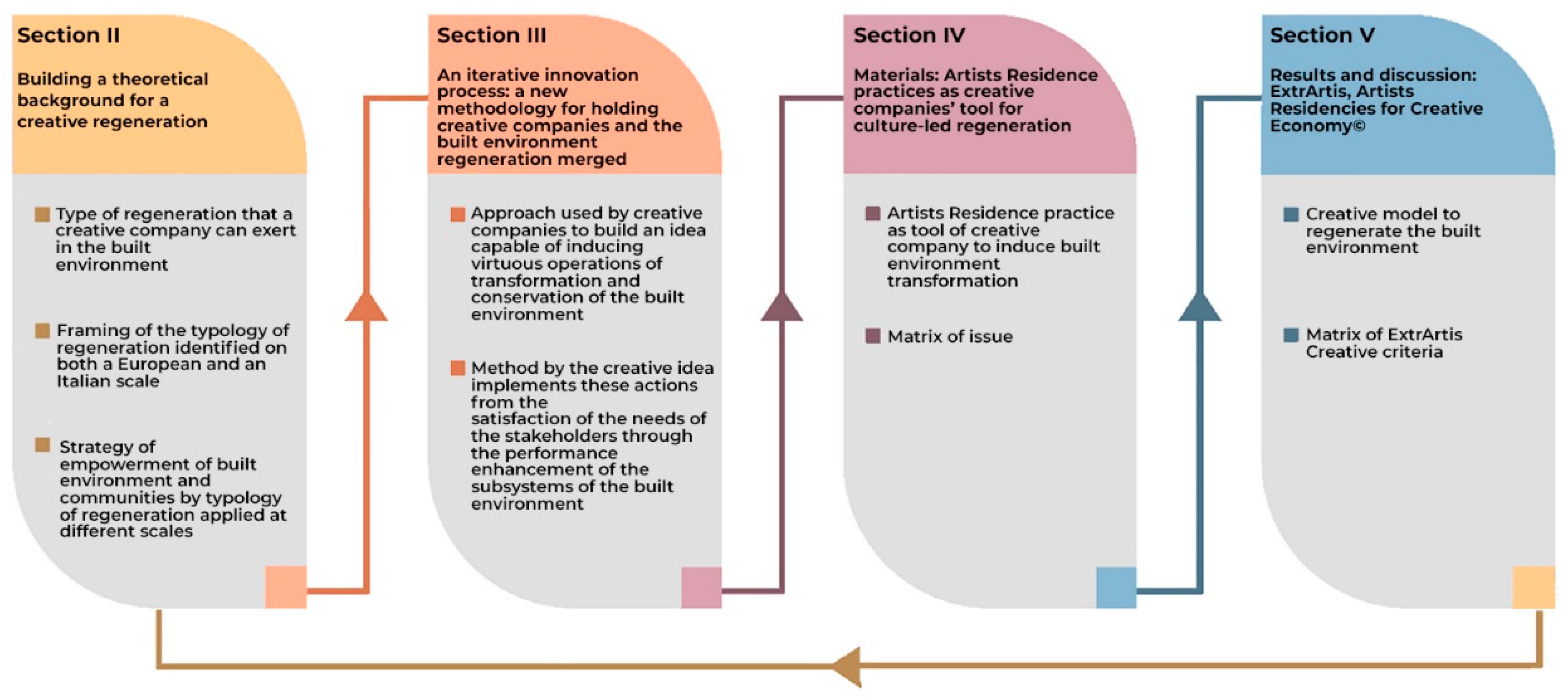
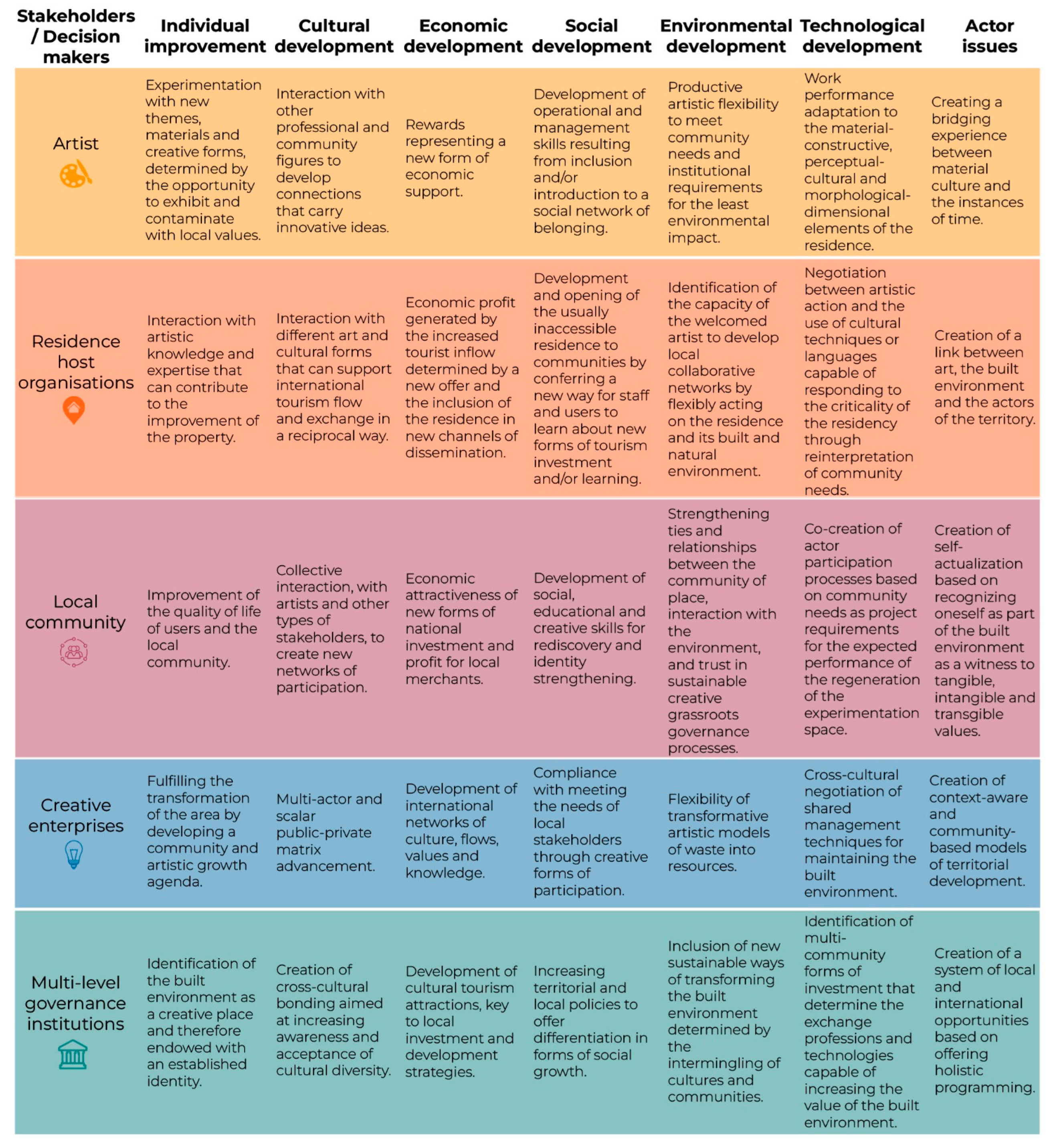
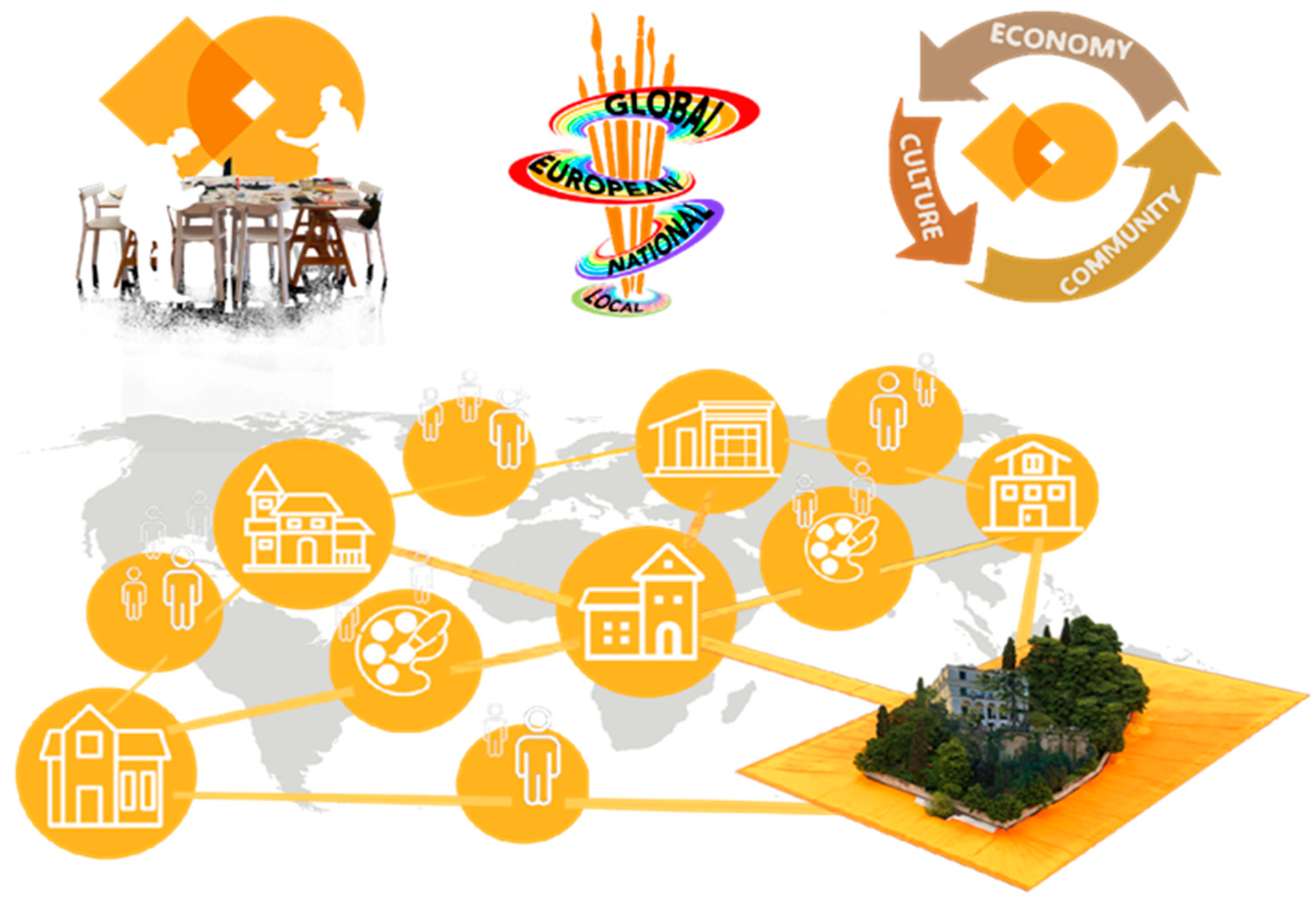
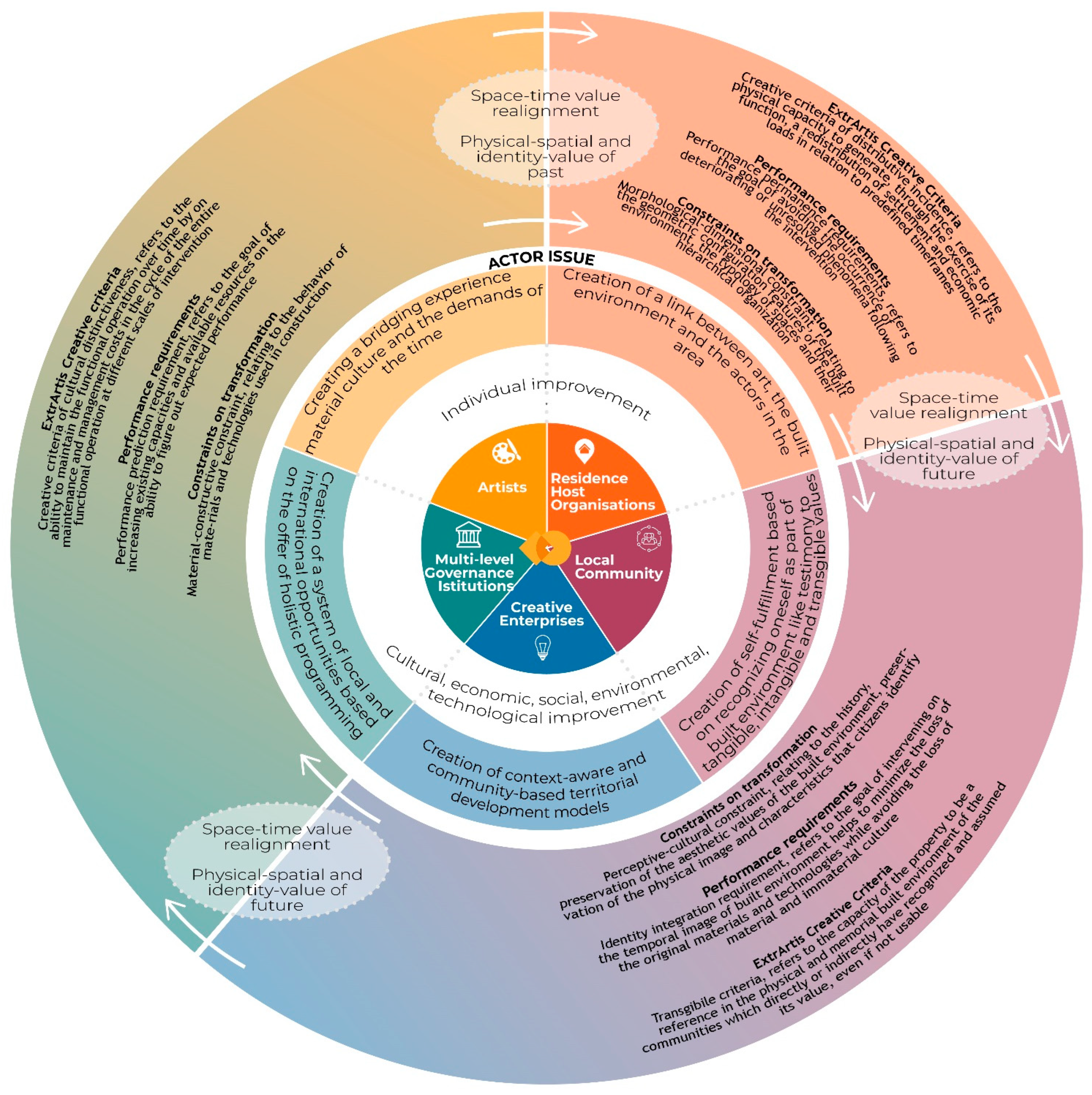
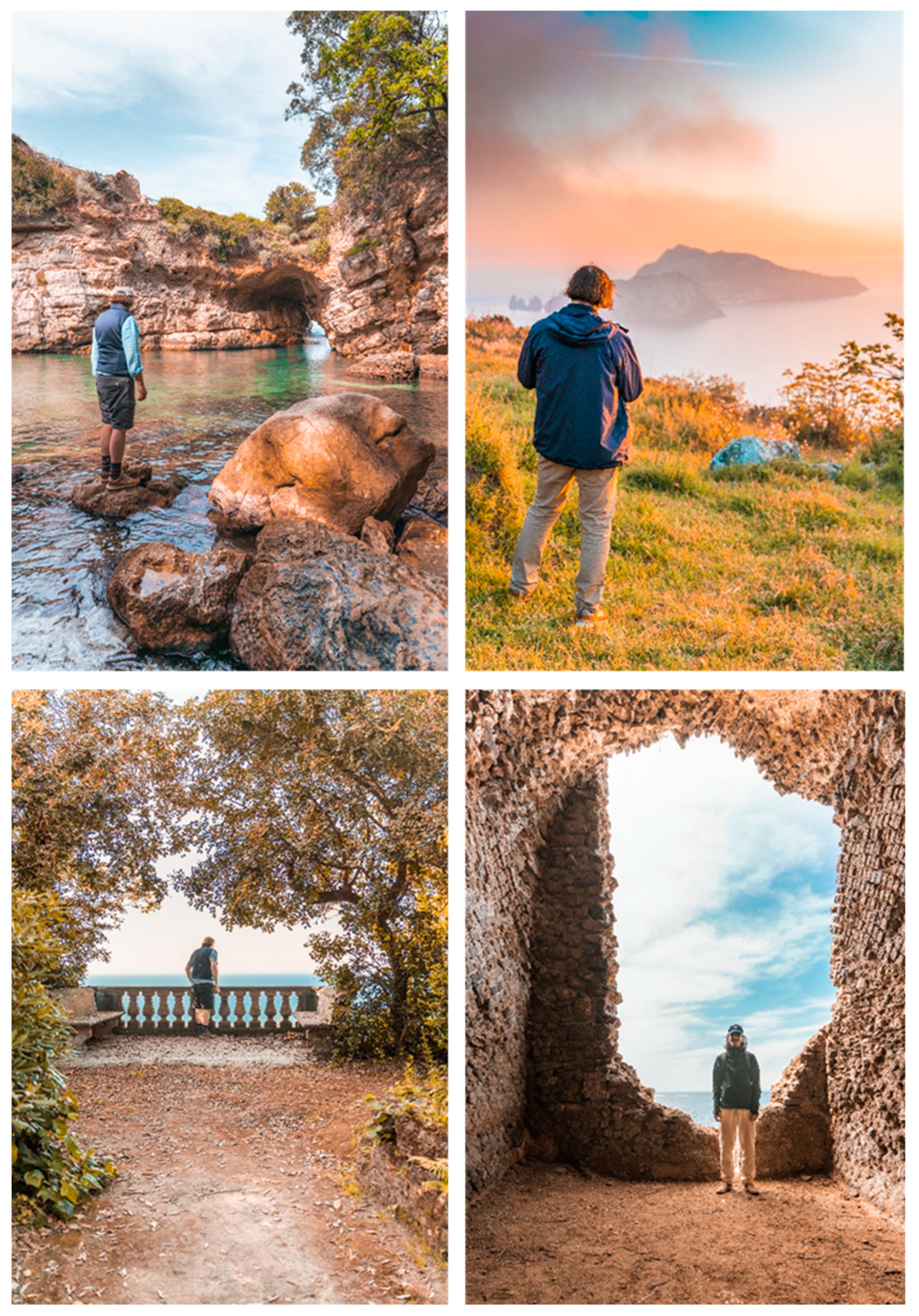
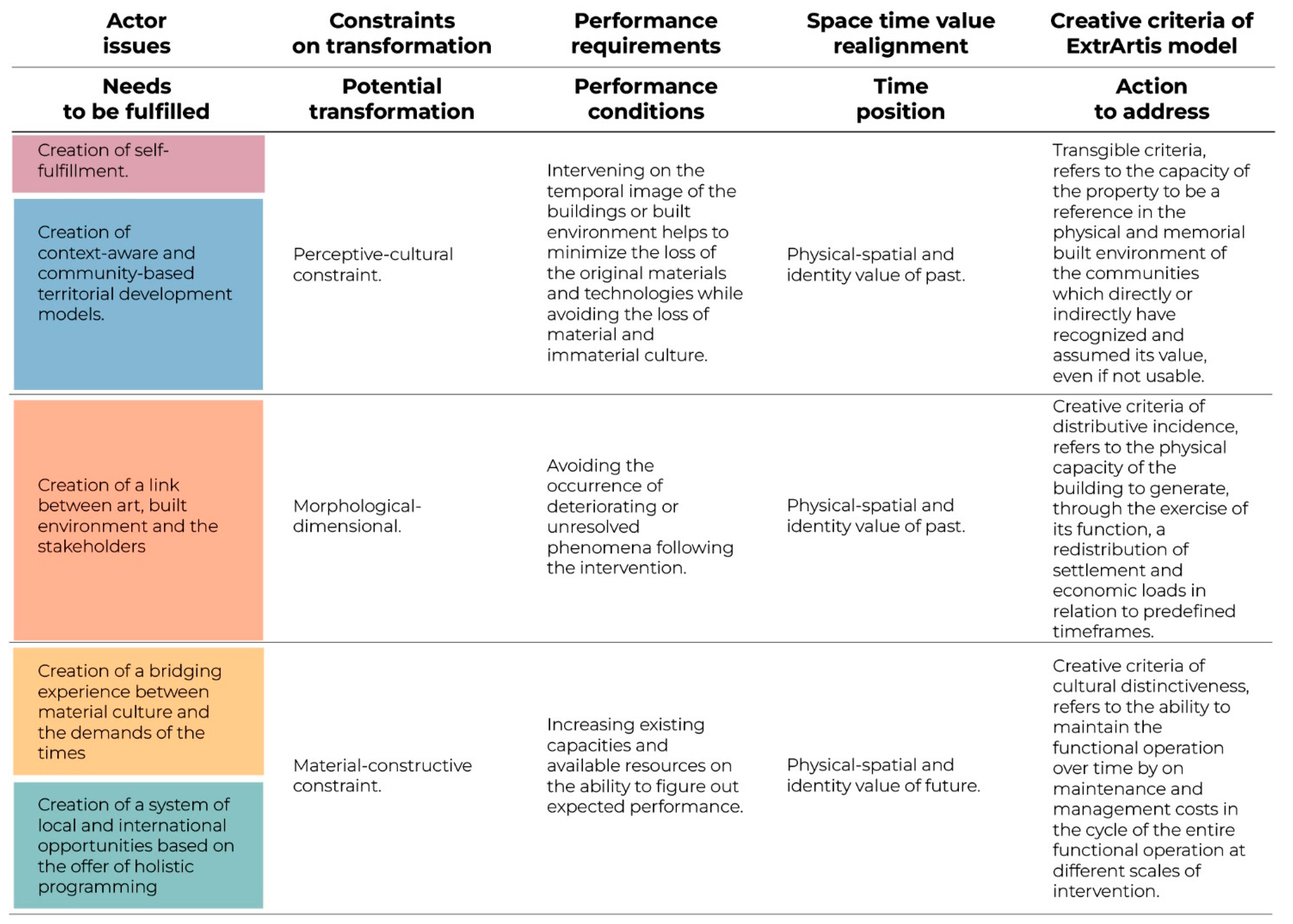
Disclaimer/Publisher’s Note: The statements, opinions and data contained in all publications are solely those of the individual author(s) and contributor(s) and not of MDPI and/or the editor(s). MDPI and/or the editor(s) disclaim responsibility for any injury to people or property resulting from any ideas, methods, instructions or products referred to in the content. |
© 2023 by the author. Licensee MDPI, Basel, Switzerland. This article is an open access article distributed under the terms and conditions of the Creative Commons Attribution (CC BY) license (https://creativecommons.org/licenses/by/4.0/).
Share and Cite
Ciampa, F. A Creative Approach for the Architectural Technology: Using the ExtrArtis Model to Regenerate the Built Environment. Sustainability 2023, 15, 9124. https://doi.org/10.3390/su15119124
Ciampa F. A Creative Approach for the Architectural Technology: Using the ExtrArtis Model to Regenerate the Built Environment. Sustainability. 2023; 15(11):9124. https://doi.org/10.3390/su15119124
Chicago/Turabian StyleCiampa, Francesca. 2023. "A Creative Approach for the Architectural Technology: Using the ExtrArtis Model to Regenerate the Built Environment" Sustainability 15, no. 11: 9124. https://doi.org/10.3390/su15119124
APA StyleCiampa, F. (2023). A Creative Approach for the Architectural Technology: Using the ExtrArtis Model to Regenerate the Built Environment. Sustainability, 15(11), 9124. https://doi.org/10.3390/su15119124





